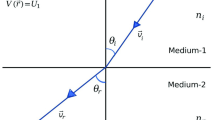Abstract
Geometrical theory of diffraction (GTD) is an alternative model of diffraction propounded first by Thomas Young in 1802. GTD has a long history of nearly 150 years over which many eminent people enriched this model which has now become an accepted tool in the calculation of diffraction patterns. In the conventional Helmholtz-Kirchhoff theory the diffracted field is obtained by computing the net effect of the waves emitted by all points within the area of the aperture. But GTD reduces this problem to one of computing the net effect of waves from a few points on the boundary of the aperture or obstacle, thus simplifying considerably the labour involved in computations. Also the theory can easily be modified to include polarization effects. This has been done specifically by Keller (1962) who exploited the Sommerfeld solution of diffraction of electromagnetic waves at a half plane, making the theory more versatile than the Kirchhoff scalar wave theory. Interestingly the geometry of difffracted rays is predictable from a generalized Fermat principle. According to this the total path chosen by light from the source to the point of observation via the diffracting boundary is an extremum. Historically it should be stated that many of the salient features of GTD were established by a school led by Raman which was active from 1919–1945. Later when Keller (1962) revived GTD independently, he and others who followed him rediscovered many of the results of the Raman school. We have stressed wherever necessary the contributions of the Indian School. We have also discussed certain geometries where GTD can be effectively used. We get some new and interesting results, which can be easily understood on GTD, but are difficult to interpret on the conventional theory of diffraction.
Similar content being viewed by others
References
Ananthanarayanan N 1940Proc. Indian Acad. Sci. A10 477
Banerji S K 1919Philos. Mag. 37 112
Burnside W D and Bergener K W 1983IEEE Trans. 31 104
Coulson J and Becknell G G 1922Phys. Rev. 20 594
English R E and George N 1988Appl. Opt. 27 1581
Kalaschnikow 1912J. Russ. Phys. Soc. 44 133
Kathavate Y V 1945Proc. Indian Acad. Sci. A21 177
Keller J B 1956IRE Trans. Antennas and Propagation AP24 312
Keller J B 1957J. Appl. Phys. 28 426
Keller J B 1962J. Opt. Soc. Am. 52 116
Kouyoumjian R G and Pathak P H 1974Proc. IEEE Trans. 62 1448
Laue Von. M 1936Berliner Sitzungsberichte p. 89 (see also Jame R W 1967The optical principles of the diffraction of X-rays G. Bell and Sons Ltd.)
Maey E 1893Ann. Phys. (Lpz)49 93
Maggi G A 1888Ann. di. Mat. 11a 16
McNamara D A, Pistorius C W I and Malherbe J A G 1990Introduction to uniform geometrical theory of diffraction (Artech House, Norwood) and references therein
Mitra S K 1919Philos. Mag. 38 289
Mitra S K 1920Proc. Indian Assoc. Cultiv. Sci. 6 1
Miyamoto K and Wolf E 1962J. Opt. Soc. Am. 52 615, 626
Nienhuis K 1948Thesis, Gröningen
Ramachandran G N 1944Proc. Indian Acad. Sci. A19 123
Ramachandran G N 1945Proc. Indian Acad. Sci. A21 165
Raman C V 1919Phys. Rev. 13 259
Raman C V 1941Sayaji Rao Gaekwar foundation lectures on physical optics (Indian Academy of Sciences) Published in 1959
Raman C V and Banerji B N 1921Philos. Mag. 41 338
Raman C V and Ghosh P N 1918Nature (London) 102 205
Raman C V and Krishnan K S 1926Proc. Phys. Soc. (London) 38 350
Raman C V and Krishnan K S 1927Proc. R. Soc. (London) A116 254
Raman C V and Ramakrishna Rao I 1927Proc. Phys. Soc. (London) 39 453
Riemann-Weber 1927Differential Gleichungen Phys. 2 594
Rubinowicz A 1917Ann. Phys. 53 257
Rubinowicz A 1924Ann. Phys. 73 339
Savornin J 1939Ann. Phys. 11 129
Sommerfeld A 1896Math. Ann. 47 317
Sunil Kumar P B and Ranganath G S 1991Curr. Sci. 61 22
Young T 1802Philos. Trans. R. Soc. (London) 20 26
Author information
Authors and Affiliations
Rights and permissions
About this article
Cite this article
Kumar, P.B.S., Ranganath, G.S. Geometrical theory of diffraction. Pramana - J Phys 37, 457–488 (1991). https://doi.org/10.1007/BF02846778
Received:
Revised:
Issue Date:
DOI: https://doi.org/10.1007/BF02846778




